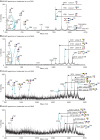Targeted glycoproteomic identification of cancer cell glycosylation
- PMID: 19433864
- PMCID: PMC2704901
- DOI: 10.1093/glycob/cwp065
Targeted glycoproteomic identification of cancer cell glycosylation
Abstract
GalMBP is a fragment of serum mannose-binding protein that has been modified to create a probe for galactose-containing ligands. Glycan array screening demonstrated that the carbohydrate-recognition domain of GalMBP selectively binds common groups of tumor-associated glycans, including Lewis-type structures and T antigen, suggesting that engineered glycan-binding proteins such as GalMBP represent novel tools for the characterization of glycoproteins bearing tumor-associated glycans. Blotting of cell extracts and membranes from MCF7 breast cancer cells with radiolabeled GalMBP was used to demonstrate that it binds to a selected set of high molecular weight glycoproteins that could be purified from MCF7 cells on an affinity column constructed with GalMBP. Proteomic and glycomic analysis of these glycoproteins by mass spectrometry showed that they are forms of CD98hc that bear glycans displaying heavily fucosylated termini, including Lewis(x) and Lewis(y) structures. The pool of ligands was found to include the target ligands for anti-CD15 antibodies, which are commonly used to detect Lewis(x) antigen on tumors, and for the endothelial scavenger receptor C-type lectin, which may be involved in tumor metastasis through interactions with this antigen. A survey of additional breast cancer cell lines reveals that there is wide variation in the types of glycosylation that lead to binding of GalMBP. Higher levels of binding are associated either with the presence of outer-arm fucosylated structures carried on a variety of different cell surface glycoproteins or with the presence of high levels of the mucin MUC1 bearing T antigen.
Figures







References
-
- Abu-Qarn M, Yurist-Doutsch S, Giordano A, Trauner A, Morris HR, Hitchen P, Medalia O, Dell A, Eichler J. Haloferax volcanii AglB and AglD are involved in N-glycosylation of the S-layer glycoprotein and proper assembly of the surface layer. J Mol Biol. 2007;374:1224–1236. - PubMed
-
- Bray J, Lemieux RU, McPherson TA. Use of a synthetic hapten in the demonstration of the Thomsen-Friedenreich (T) antigen on neuraminidase-treated human red blood cells and lymphocytes. J Immunol. 1981;126:1966–1969. - PubMed
-
- Burchell JM, Mungul A, Taylor-Papadimitiriou J. O-Linked glycosylation in the mammary gland: Changes that occur during malignancy. J Mammary Gland Biol Neoplasia. 2001;6:355–364. - PubMed
-
- Burnette WN. “Western blotting”: Electrophoretic transfer of proteins from sodium dodecyl sulfate-polyacrylamide gels to unmodified nitrocellulose and radiographic detection with antibody and radioiodinated protein A. Anal Biochem. 1981;112:195–203. - PubMed
-
- Coombs PJ, Graham SA, Drickamer K, Taylor ME. Selective binding of the scavenger receptor C-type lectin to Lewisx trisaccharide and related glycan ligands. J Biol Chem. 2005;280:22993–22999. - PubMed
Publication types
MeSH terms
Substances
Grants and funding
LinkOut - more resources
Full Text Sources
Other Literature Sources
Molecular Biology Databases
Research Materials
Miscellaneous

